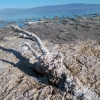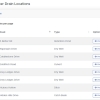
*The screenshots used in this article are from Roadwurx, an asset management software created for road maintenance departments.
Managing a town’s stormwater system can quickly become overwhelming when maintenance and inspection records are scattered across clipboards, spreadsheets, or dusty file cabinets. Every catch basin, culvert, dry well, and retention pond needs routine attention to function properly and stay in compliance with environmental regulations. The key to staying organized and efficient is to manage these assets with purpose, and that begins with using a dedicated asset management system.
An asset management system turns your stormwater network into a digital map of actionable information. Each drainage location can be logged with its coordinates, type, installation date, condition, photos, maintenance and inspection histories. Instead of searching through years of paper records, you can instantly pull up a complete history for any asset and see when it was last inspected, cleaned, or repaired. This is invaluable during storm events, regulatory audits, or town board meetings when quick, accurate answers matter most.

Beyond convenience, the reporting capabilities of an asset management system can transform how a department plans its work. When all inspection and maintenance records are digitized, patterns emerge - like which culverts tend to clog after heavy rain or which neighborhoods need more frequent cleaning. These insights allow you to prioritize maintenance, justify budget requests with data, and document compliance with MS4 or local stormwater mandates. Over time, this data becomes a powerful planning tool that helps you allocate staff and equipment more efficiently while extending the lifespan of your infrastructure.

Another major advantage is consistency. When every staff member records data in the same digital format, the result is a standardized and defensible record of your operations. Whether a new superintendent takes over or a consultant needs access to the system, everything from inspection photos to replacement costs is easy to find and understand. This continuity protects your department against liability claims and ensures that institutional knowledge isn’t lost when personnel changes occur.
In short, maintaining your stormwater drainage system with asset management software eliminates guesswork, saves time, and strengthens accountability. It provides the organized, data-driven foundation every highway or public works department needs to maintain clean water, prevent flooding, and stay compliant with evolving environmental standards.
 Wetlands are often described as the kidneys of the watershed because they filter, slow, and transform the water that passes through them in ways that …
Wetlands are often described as the kidneys of the watershed because they filter, slow, and transform the water that passes through them in ways that …
 Field inspections of catch basins, manholes, culverts, and outfalls form the foundation of responsible stormwater management. These routine checks giv…
Field inspections of catch basins, manholes, culverts, and outfalls form the foundation of responsible stormwater management. These routine checks giv…
 Habitat disruption around drainage structures is often subtle at first, and many of the earliest signs tend to appear during ordinary field work rathe…
Habitat disruption around drainage structures is often subtle at first, and many of the earliest signs tend to appear during ordinary field work rathe…
 Harmful algal blooms have become one of the most pressing water quality problems in many regions, and their rise has been linked to a complicated blen…
Harmful algal blooms have become one of the most pressing water quality problems in many regions, and their rise has been linked to a complicated blen…
 The Salton Sea is one of California’s most unusual and tragic landscapes, a place shaped by accident, transformed by ambition, and ultimately pu…
The Salton Sea is one of California’s most unusual and tragic landscapes, a place shaped by accident, transformed by ambition, and ultimately pu…
 *The screenshots used in this article are from Roadwurx, an asset management software created for road maintenance departments. Managing a town’…
*The screenshots used in this article are from Roadwurx, an asset management software created for road maintenance departments. Managing a town’…